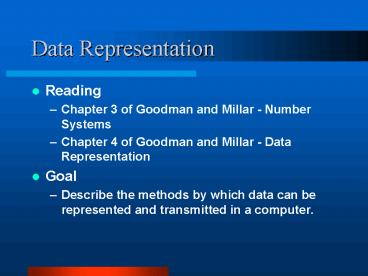Data Representation - PowerPoint PPT Presentation
1 / 11
Title:
Data Representation
Description:
Chapter 4 of Goodman and Millar - Data Representation. Goal. Describe the methods by which data can be represented and transmitted in a computer. ... – PowerPoint PPT presentation
Number of Views:99
Avg rating:3.0/5.0
Title: Data Representation
1
Data Representation
- Reading
- Chapter 3 of Goodman and Millar - Number Systems
- Chapter 4 of Goodman and Millar - Data
Representation - Goal
- Describe the methods by which data can be
represented and transmitted in a computer.
2
Introduction
- Inside a computer all data must be coded in a
binary format - Coding format used will depend on the type of
data - e.g. consider the number 9
- 9 may be represented as 1001
- -9 may be represented as 10111
- 9.0 may be represented as 0000010010000001
- the character 9 may be represented as 0111001
3
Introduction
- When a coding format is being devised a number of
considerations need to be made - Ease of manipulation
- Conciseness and machine efficiency
- Accuracy
- Standardised data communication
4
Binary Data Representation
- Some things that a computer may represent are
- A machine instruction
- A numeric quantity
- A character
- A graphic
- A sound
- Machine Instructions
- Relationship between an instruction and its bit
pattern is determined by the computer designer
(e.g. the same bit pattern on the 68000 will have
a different effect on an 8086)
5
Numbers
- Need to represent ve and -ve numbers as well as
very small and very large numbers - Number formats include BCD, signed magnitude,
excess notation, two compliment, floating point. - Both decimal and Binary number systems are forms
of positional number systems - e.g. 372910 3 x103 7 x 102 2 x 101 9 x
100 101102 1 x 24 0 x 23 1 x 22 1 x 21
0 x 20 2210
20
2-1
2-2
2-3
2-4
21
22
23
24
25
32
16
8
4
2
1
.
1/2
1/4
1/8
1/16
6
Numbers
- representation of binary numbers pose problems
for people - hard to read
- easy to make errors
- e.g. consider 1010011101011100
- To minimise these errors use a different number
system - Hexadecimal
- Base 16
- Uses the digit values 0, 1, 2, 3, 4, 5, 6, 7, 8,
9, A, B, C, D, E, F - Each hex digit represents 4 binary digits
- e.g. 10100111010111002 A75C
- require 2 hex digits per byte
7
Numbers
- Octal
- Base 8
- Uses the digit values 0, 1, 2, 3, 4, 5, 6, 7
- e.g. 10100111010111002 1235348
8
Numeric Representation
- BCD (binary coded decimal)
- Each Decimal digit is coded as a 4 bit binary
code - Developed for early calculators
- e.g. 35910 0011 0101 1001bcd
- Easy for people to understand, Hard for computers
to work with - Signed Magnitude
- Extra bit added to the code to represent the sign
- In most cases
- a 0 represents a ve
- a 1 represents a ve
9
Excess Notation
- fix number of bit positions used
- smallest number with 1 in the MSB represents zero
(e.g. 1000) - All bit strings greater than this represent ve
numbers - All bit strings less than this represent -ve
numbers - Example is known as excess eight notation because
8 (100) represents zero
10
Twos Complement
- Can represent numbers in the range -2n-1 to
(2n-1-1) - One representation of zero
- Can be sign extended
- 510 00000101 0000000000000101
- -510 11111011 1111111111111011
Binary
Negative
Compliment
Positive
0 1
1 0
1
Result
11
Twos Complement
0
-1
1
-2
0000
1111
1110
0001
-3
2
1101
0010
-4
3
0011
1100
-5
1011
4
0100
1010
0101
-6
5
1001
0110
6
-7
0111
1000
7
-8































